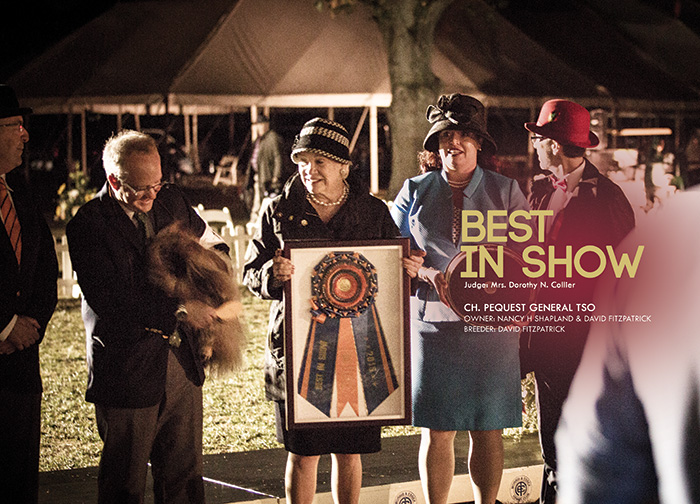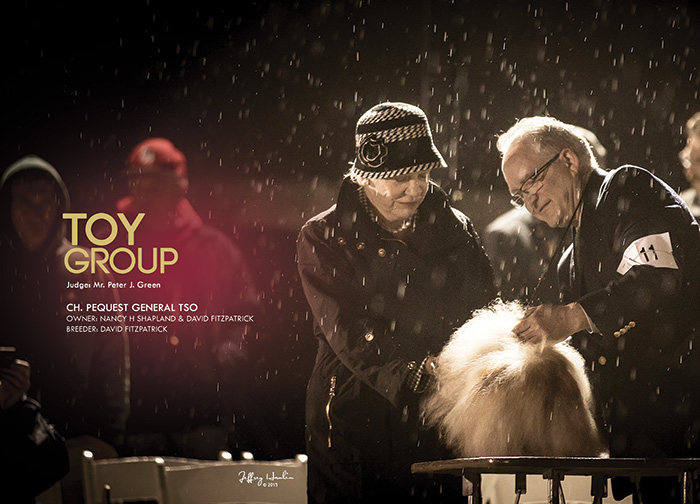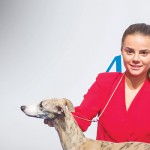Written by Bo Bengtson for Dog News • Photo credis: Jeffrey Hanlin
Published in Best in Show Annual 2016
It was one of the greatest dog shows ever held in the United States. Even Mrs. Dodge, the great lady who created Morris & Essex Kennel Club almost a century ago, would have been impressed. Although she was, of course, not present in person I suspect that most of us felt her spirit pervade nearly every aspect of the event.
This year’s Morris & Essex Kennel Club show was only the fourth one held since this famous old club was reborn after many years of being just a memory. Now held only once every five years, the 2015 show was the first for the club since 2010. Again it took place at Colonial Park in Somerset, New Jersey. The date, October 1st 2015, was a Thursday, — not usually the ideal day for holding a huge dog show.
Nevertheless, there was an entry of 4,152 dogs making 4,666 entries, among the highest figures reached for a dog show in the U.S. According to AKC’s event statistics a total of 3,561 dogs were present and competing; the weather probably accounted for more absentees than usual, but that total still makes this one of the largest AKC shows in more than a decade. (Last year’s AKC/Eukanuba show in Florida in December had a few dozen fewer dogs in competition than this M&EKC; this year’s show, a few weeks after Morris & Essex, turned out to be even bigger.) The Kennel Club of Palm Springs in California has had entries as big as M&E, but you have to go back to the Louisville weekend in 2004 to find a show that actually had more dogs on view than this one.
Other figures: There were 121 judges for 189 breeds, including 44 sweepstakes assignments, incorporating 32 specialties and 89 supported entries in 29 rings with 46 ring stewards. There were 1,870 feet of tenting (more than a third of a mile!), three mega-power generators providing electricity and 2.3 miles of electric cable, eliminating the need for private generators for grooming. In addition to 3,000 regular parking spaces there were 425 RV spaces and 45 golf carts shuttling visitors from the parking lots to the show. The immediate show grounds are 20 acres; Colonial Park is approx. 2 square miles.
There was a catalog of 568 pages; just the exhibitors’ index covered more than 50 pages in fine print. The premium list of 81 pages was reportedly the largest ever presented. Exactly 189 silver-plated Revere bowls were awarded, one to every BOB winner, as well as 700 rosettes and countless other trophies donated by supporting clubs and individuals in the various breed classes. Serious silverware was offered for Group placements and BIS, and Purina Pro-Plan, the event’s official sponsor, donated various items to all Group and Breed winners, as well as to every Puppy class winner in every breed!
Most importantly, throughout the day there was a spirit of good cheer, cameraderie and sincere enjoyment of the sport of purebred dogs that isn’t common at all-breed shows these days. It must have been tough to live up to the expectations that we writers in the dog press have created, and it’s even more difficult to do this when you hold the show only once every five years — but I think Morris & Essex Kennel Club succeeded admirably against almost overwhelming odds.
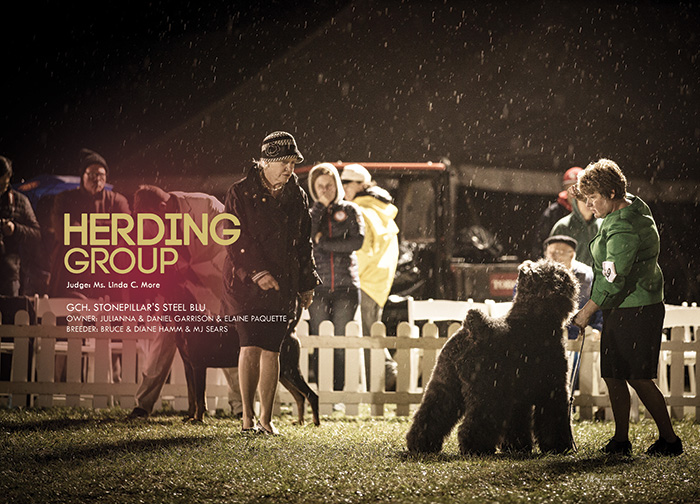
WHAT’S SPECIAL ABOUT MORRIS & ESSEX
So what’s the big deal, you ask? What’s so special about Morris & Essex Kennel Club? Most people know the history by now, but let me briefly reiterate it for the uninitiated. One of America’s wealthiest women in the first part of the 20th century, Geraldine Rockefeller Dodge, was an avid dog fancier and owned the luxurious Giralda kennels, situated on her 550-acre estate in Madison, New Jersey. (Her husband, Marcellus Dodge, raised horses on a separate, even larger, adjoining parcel.) At its height there were as many as 150 dogs at Giralda, including scores of champion German Shepherd Dogs, Pointers, Beagles, Bloodhounds, Cocker Spaniels and other breeds. Mrs. Dodge won Best in Show at Westminster twice, in 1932 with the Pointer Ch. Nancolleth Markable and in 1939 with the Doberman Ch. Ferry v. Rauhfelsen of Giralda, imported from England and Germany, respectively. She also judged BIS at Westminster, the first woman to do so single-handedly, putting up the Airedale Terrier Ch. Warland Protector of Shelterock in 1933.
In the 1920s Mrs. Dodge began to invite dog fanciers to Giralda for what would today be described as a breed seminar. There was no “show” per se, but a number of the country’s top dogs of her then-favorite breed, the German Shepherd Dog, were invited to go through their paces on Mrs. Dodge’s immaculate, vast lawn in front of a select group of breed specialists. Spirited discussion about breed points and ideal type would ensue. By 1927 these informal get-togethers had developed into an AKC-recognized dog show, although still limited to just those breeds that Mrs. Dodge personally felt would appreciate her patronage. The first year 595 dogs were entered, but word soon spread of the beauty of the show, the excellence of the arrangements, the interesting judges and Mrs. Dodge’s hospitality. (Traditionally, at precisely 12:00 noon all judging stopped and every exhibitor was treated to lunch, courtesy of Mrs. Dodge.) By 1935 more than 3,000 dogs were entered, and a peak was reached in 1939 when the famous Cocker Spaniel Ch. My Own Brucie won BIS over 4,456 dogs. (The show report that year makes it clear that this figure denotes the number of dogs entered, not the number of “entries,” which may of course be higher if some dogs compete in multiple classes.) The shows at Mrs. Dodge’s estate could without any exaggeration be said to be the event of the summer season for dog people, outstripping all others for size and elegance, even becoming recognized as the world’s largest of its kind.
After a five-year break during World War II the Morris & Essex show returned in 1947 and was still going strong ten years later. In 1958, however, Mrs. Dodge encountered resistance from AKC. There are conflicting stories of exactly what transpired, but the upshot was that Mrs. Dodge cancelled the show for good and instead focused on her shelter for homeless dogs. Two years after her death in 1973 Sotheby’s in New York auctioned off 2,000 of Mrs. Dodge’s personal items, mostly dog-related (“from jewels to junk,” according to press accounts), raising more than $5 million for her dog shelter. Mrs. Dodge’s entire estate ran into hundreds of millions.
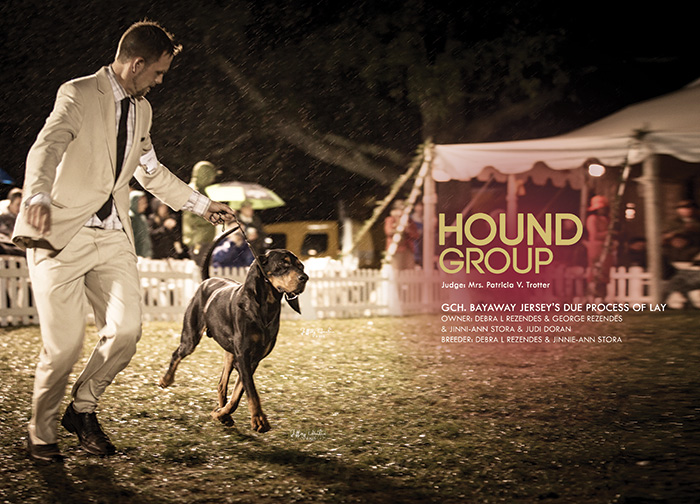
A FADED BUT BEAUTIFUL MEMORY
By the end of the 1900s Morris & Essex was becoming a faded but beautiful memory. However, one individual had the brilliant idea of revitalizing the club and holding a show in the spirit of Mrs. Dodge. Wayne Ferguson managed to gather a core group of enthusiasts behind this thought, and in 2000 the first “modern” M&EKC show was held in Madison, New Jersey, on the grounds where Mrs. Dodge’s estate used to be. The show attracted 2,992 dogs making 3,223 entries and was a huge success.
It was impossible for a “new” club to get a weekend date in the already over-crowded AKC show calendar, even for a show as prestige-laden as Morris & Essex, particularly since it was soon determined that a show this special could be held only once every five years. Wisely, therefore, it was decided to hold M&EKC on the Thursday before two of the East Coast’s most well-established shows, Hatboro and Devon, with the world-famous Terrier extravaganza that is Montgomery County concluding the weekend. With Hatboro now holding two all-breed shows — one on Wednesday before M&EKC and one the day after — I was grateful I did not have to show (or groom) Terriers for five days in a row: it would have been truly exhausting. Of course, since the Devon show on Saturday was cancelled due to the ungodly weather, even the Terrier people got a day of rest. The huge Terrier entries certainly helped the all-breed shows, with the Terrier group having several hundred more entries than any other at M&E.
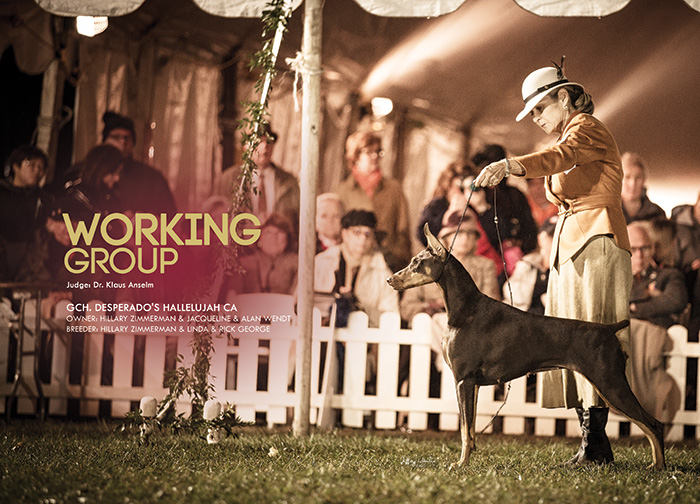
Not surprisingly, several Terrier breeds were among those with 50 or more dogs entered: West Highland White Terrier 86, Soft-Coated Wheaten Terrier and Kerry Blue Terriers 79 each, Border Terriers 78, English Springer Spaniels and Cairn Terriers 73 each, Norwich Terriers 68, Miniature Schnauzers 67, Scottish Terriers 64, Airedale Terriers 63, Newfoundlands 61, Rhodesian Ridgebacks 59, Flat-coated Retrievers and Labrador Retrievers 56 each, Pomeranians 54 and English Cocker Spaniels 52 dogs entered. At least another 15 breeds had 40-49 dogs, but there were also a few inexplicably low figures: How could there be a record 19 specimens of the Cirneco dell’Etna entered, a breed most American dog fanciers still can’t recognize (think miniature Pharaoh Hound!), but only 6 Alaskan Malamutes, a single St. Bernard, 7 Toy Poodles, 3 Shih Tzu, 3 Chow Chows, 5 Lhasa Apsos, just 1 Australian Cattle Dog and 12 German Shepherds?
One could sympathize with the longcoated Toy dog exhibitors: An outdoor show in October isn’t the best place to show off your grooming skills. The weather didn’t help. It started out cold and windy, improved during the day, but as the second Group was going into the ring the rain started to fall, and soon ringside was a sea of umbrellas. It says a lot for the enthusiasm of the spectators that very few left: Ringside was crowded throughout, and the huge tent that provided both shelter and sustenance, as per the superb M&E hospitality, was probably not the only reason so many stuck around. Having Dave Frei as announcer was another genius stroke: his dulcet tones have graced Westminster for years now and lend an immediate air of authority to any event.
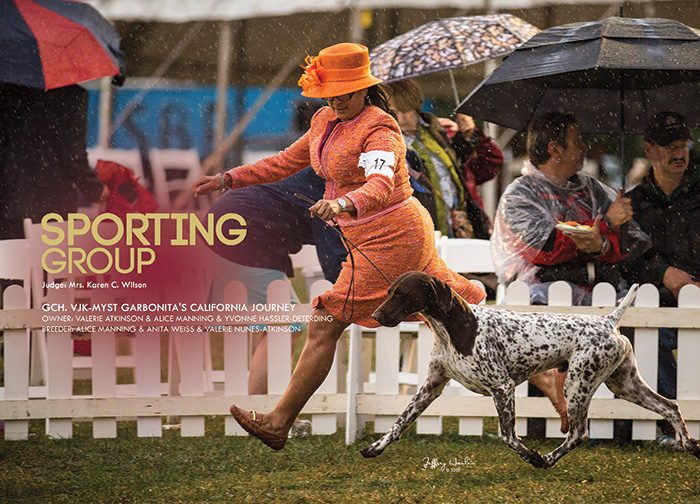
ART SHOW WITH $1,000 TO “BEST IN SHOW”
There are so many other wonderful things that deserve to be mentioned. There was the art show, with seven “group winners” and a check for $1,000 to Best in Show. The judge was William Secord, world-renowned authority on dog painting and founding director of The Dog Museum of America. His winner was Christine Dabba’s wonderful rendition of a French Bulldog, “Frenchie.” There were the stylish period outfits worn by some fashion-conscious exhibitors and judges, and the fantasy outfits that others created. There was a magnificent trophy display that can be matched by no other show that I know of, and the unique historical artifacts that would do any club proud. There was the Group trophy from Morris & Essex 1951, won by the immortal Boxer Ch. Bang Away of Sirrah Crest, displayed courtesy of the Boxer Heritage Foundation. (Bang Away never won BIS at M&E, but his daughter Ch. Baroque of Quality Hill did, in 1955.) There was the superb luncheon for judges and officials and 4,152 free “box lunches” — one for every single exhibitor …
So what could be improved? Don’t expect me to be impartial: I have always been a strong supporter of this show’s historical importance and emphasis on a bygone era — but of course there were some things that didn’t work as perfectly as one could have wished. That it took almost an hour to get into the show in the morning was probably unavoidable: The roads leading into the park aren’t designed for this much traffic, and apparently an additional delay was caused by a fallen tree. Personally I didn’t have any problems with that; if you go to a show with more than 4,000 dogs entered in one day you can’t expect parking to be as easy as at an 800-dog event, but there were some frayed nerves, even though judging was postponed by half an hour.
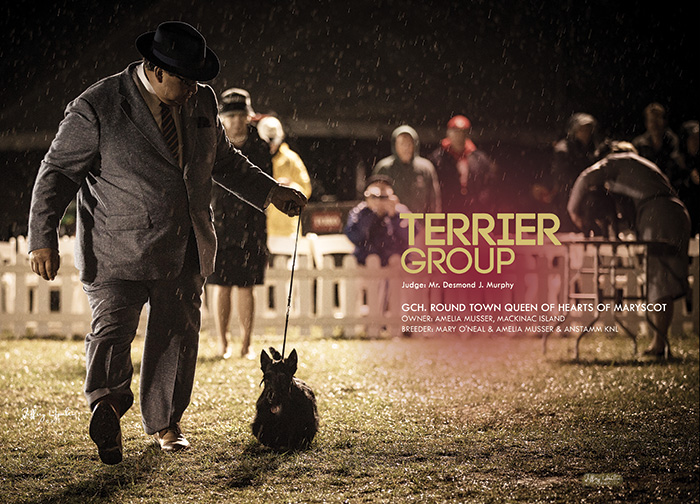
EVEN MRS. DODGE WOULD HAVE BEEN IMPRESSED
Not surprisingly, a lot of the country’s top dogs were competing in the finales. Exhibitors came from 50 states, but three of the leading contenders were conspicuous by their absence: The German Shepherd bitch who’s an easy leader for Top Dog All Breeds and the Skye Terrier who is top Terrier were not entered, reportedly due to conflicts with judging interests. The Brittany who’s top Sporting Dog was not entered either; I have no idea why. Two of the other top all-breed contenders, the Pomeranian and the Whippet, both won BOB and placed in their respective Group.
The responsibility to judge BIS was originally meant to have fallen on Jane Forsyth, the legendary ex-handler and judge who with her husband, Bob, won and judged at more shows than most for several decades. Bob judged BIS at the previous Morris & Essex show, so it seemed appropriate that his wife would do the same thing now. Sadly, Jane died only a couple of months before the show, but she was represented during the Best in Show presentation by her daughter Sioux Forsyth-Green.
Mrs. Forsyth’s replacement was Dorothy Collier, herself a past top breeder, handler and Westminster BIS judge. She had an impressive line-up to choose from: all seven Group winners are multiple all-breed BIS winners. There was the German Shorthaired Pointer, not heavily specialled but with top wins at some major California shows to his credit. The Black and Tan Coonhound was a new face to me but is among the top Hounds. The Doberman Pinscher won her breed’s heavily contested national specialty and has won a whole bunch of all-breed BIS as well, while the Scottish Terrier is a Top 10 contender among all breeds. The French Bulldog, although U.S. bred and owned, has been successful at both FCI World Shows and in America, while the Bouvier des Flandres comes from Canada but has won the U.S. national and is currently one of the top Herding dogs in America.
But it was the Pekingese who won. If that came as a surprise to some it’s probably because we don’t tend to think of coated Toy dogs as winning rainy outdoor shows. As anyone who knows Pekingese will tell you, they are extremely tough dogs, however: GCh. Pequest General Tso didn’t seem at all intimidated by the elements. He now has 38 BIS to his credit and was both shown and bred by David Fitzpatrick, who also co-owns him with Nancy H. Shapland.
Another reason we may not have expected a Pekingese to win would be that history seldom repeats itself to such a degree. David won BIS at the latest Morris & Essex KC show five years ago with another Pekingese, General’s grandsire (and great-grandsire) Ch. Palacegarden Malachy, the English import that also won BIS at Westminster in 2012. David’s No. 1 All Breeds dog of 2005, Ch. Yakee If Only, is also in the pedigree, as are several generations of Pequest bitches — and, as a curiosity, even a great-grandsire who carried the Salilyn kennel name that was famous in English Springer Spaniels. I bet you didn’t know there were some Salilyn Pekingese also!
Reserve BIS went to the wonderfully extrovert German Shorthaired Pointer, GCh. VJK-Myst Garbonita’s California Journey, superbly handled by Valerie Atkinson, who is also co-breeder and co-owner. Valerie shows many breeds but it’s no secret that the German Shorthairs are her “first” breed. This one I can genuinely say I have admired from the start — I remember being impressed by him when he was a baby puppy of barely three months old.
As I said, I think even Mrs. Dodge would have been impressed. Congratulations to Wayne Ferguson and his hard-working club officials for a wonderful show. I can hardly wait until 2020!
